Key takeaways:
- Regular communication and transparency with donors are essential for building trust and aligning expectations.
- Engaging donors in meaningful dialogues and involving them in decision-making fosters a sense of partnership and investment in the cause.
- Personalizing communication and sharing challenges, alongside successes, enhances donor relationships and strengthens commitment.
- Proactive management of expectations, including addressing setbacks, can turn potential frustrations into opportunities for collaboration.
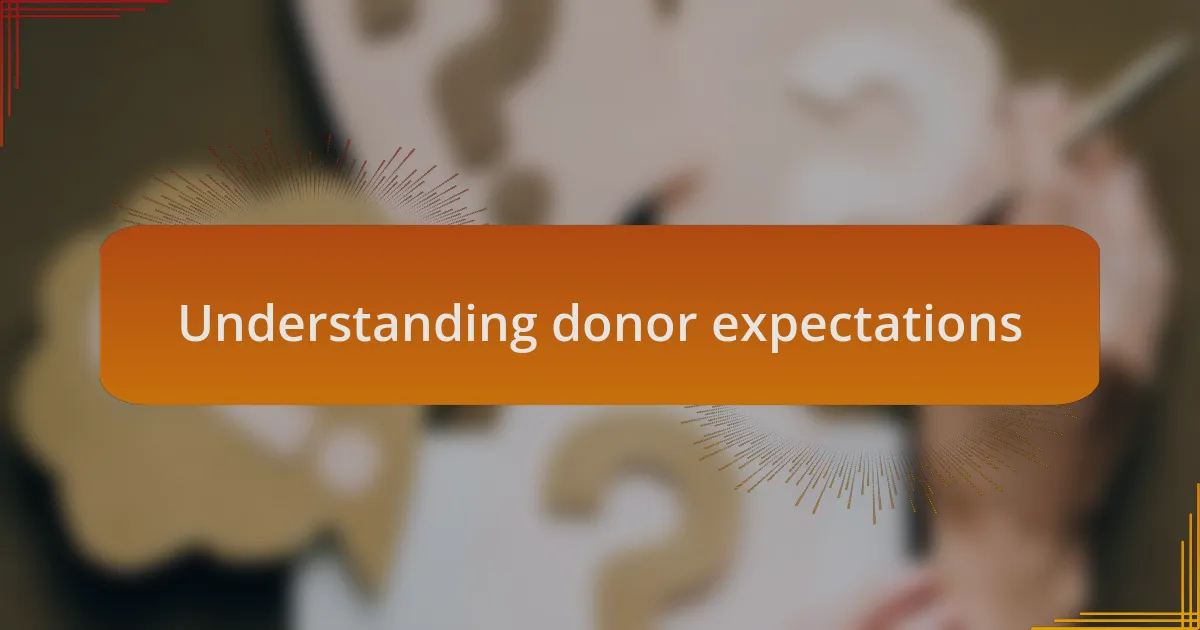
Understanding donor expectations
Donor expectations can vary widely based on personal motivations, previous experiences, and desired impacts. I remember a conversation with a donor who expressed frustration over not receiving timely updates on project progress. It struck me how crucial regular communication is for maintaining trust and understanding what donors truly hope to achieve.
In my experience, many donors want to feel a personal connection to the cause they’re supporting. One particular donor shared how they felt more invested when they could see the real-life impact of their contributions. This made me realize the significance of sharing stories and testimonials, as it bridges the gap between numbers and human experiences, allowing donors to visualize their impact more clearly.
It’s essential to acknowledge that some donors have specific objectives in mind, which might sometimes clash with organizational goals. Have you ever faced a situation where a donor wanted something the organization simply couldn’t offer? By discussing these expectations openly, I found that it’s possible to align visions and create a collaborative atmosphere, ensuring that both parties feel heard and valued.
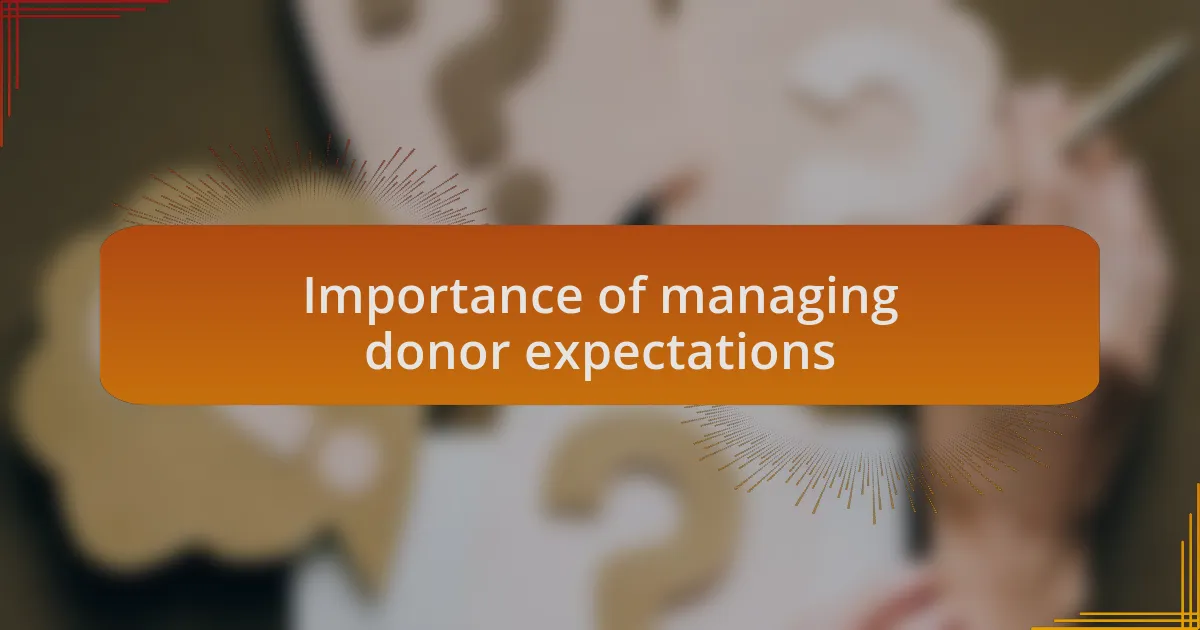
Importance of managing donor expectations
Managing donor expectations is absolutely vital for sustaining long-term relationships. I recall a situation where a major donor expected immediate results from a project that was still in its early stages. They felt disheartened, and I realized that without setting realistic timelines and clearly articulating the process, we risked losing their support. It’s a reminder that transparency can significantly influence a donor’s experience and commitment.
Moreover, addressing donor expectations isn’t just about sharing updates; it’s about fostering a sense of partnership. I once received an email from a donor who expressed a desire to be involved in strategic decisions, which initially surprised me. This opened my eyes to the idea that many donors seek a genuine collaboration rather than a one-sided financial transaction. Engaging donors in a meaningful dialogue can turn them into advocates who feel invested in the overarching mission.
I’ve also learned that mismanaged expectations can lead to disillusionment. Picture a scenario where a donor anticipated a specific outcome based on their generous giving, but the result didn’t match their expectations. It’s crucial to discuss potential challenges and realistic outcomes early on. This approach not only nurtures trust but also cultivates a more resilient relationship that can withstand setbacks. Why not ask how donors envision their contributions making a difference? This simple question can reveal insights that help us align their dreams with our goals.
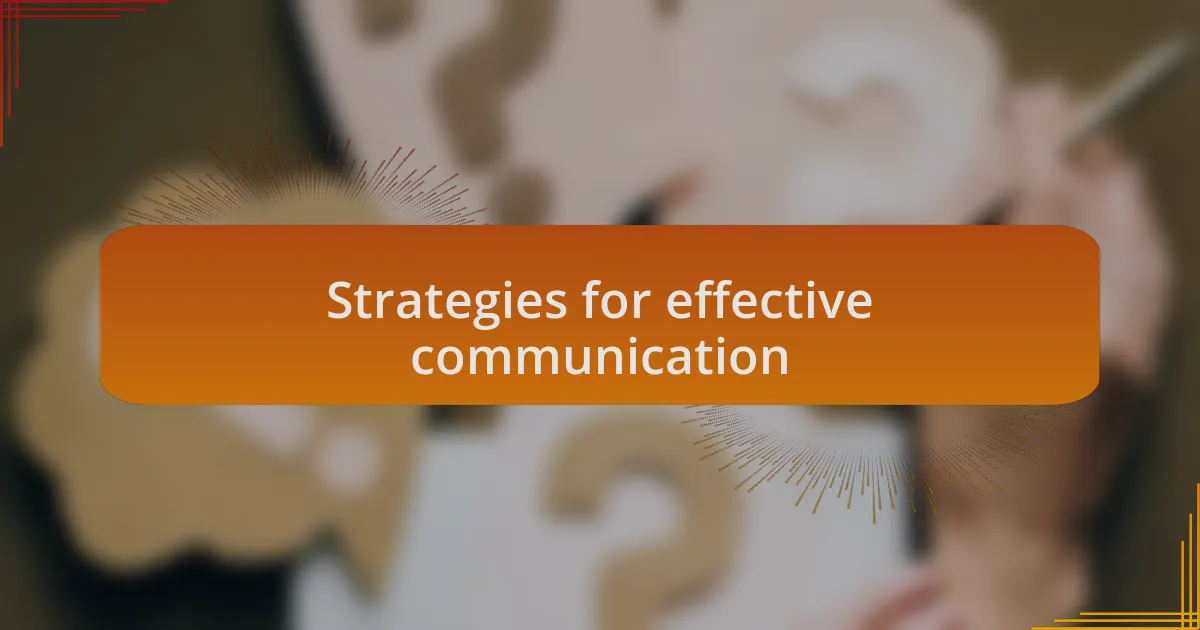
Strategies for effective communication
Effective communication starts with active listening. I remember a conversation with a donor who voiced specific concerns about the direction of a project. By simply acknowledging their feelings and taking the time to really listen, I was able to develop a tailored update that addressed their anxieties. This kind of responsiveness can transform a transaction into a dialogue, making donors feel valued and heard.
Another strategy I’ve found invaluable is regular, structured updates. One year, I implemented a quarterly newsletter for our donors, sharing not only successes but also challenges we faced. Feedback showed that donors appreciated the honesty. It builds trust when they see the full picture, and they become more invested in our journey, even during tough times. Isn’t it reassuring for donors to realize they’re part of something bigger, facing ups and downs together?
Lastly, creating opportunities for face-to-face interactions can bridge the gap between expectations and reality. I once hosted a donor roundtable to discuss preliminary findings from a funded initiative. The candid discussions that emerged were empowering, as we could directly address their thoughts and insights. Donors often leave these meetings feeling more connected and aligned with our mission. Don’t you find that authentic conversations can lead to stronger relationships? Engaging in this way transforms how donors perceive their impact and enhances their overall experience.

Building trust with donors
Building trust with donors hinges on transparency. I recall a time when my organization faced a significant funding shortfall. Instead of hiding the issue, I brought it to the donors’ attention. I explained our situation honestly and outlined our strategies to navigate the challenge. Their support during that vulnerable time deepened our relationship, as they appreciated my candor and the sense of partnership it fostered. Wouldn’t you agree that being open can transform difficult conversations into opportunities for collaboration?
Another vital aspect of trust is reliability. When I promise something to a donor, I make it a point to deliver on that commitment. I once assured a donor we would share detailed project milestones and follow-up on the impact of their contribution. Meeting those expectations allowed us to build a foundation of trust over time. Have you ever had a situation where your actions spoke louder than words? I believe that consistently fulfilling promises reinforces the idea that donors can rely on us.
Lastly, expressing genuine gratitude goes a long way in building trust. After securing a significant grant, I took the time to personally thank each donor with a handwritten note. It felt rewarding to acknowledge their unique contributions and the difference they made. In a world where gestures can be fleeting, don’t small acts of appreciation resonate deeply? By recognizing their impact, we not only strengthen trust but also encourage donors to remain engaged and committed to our cause.
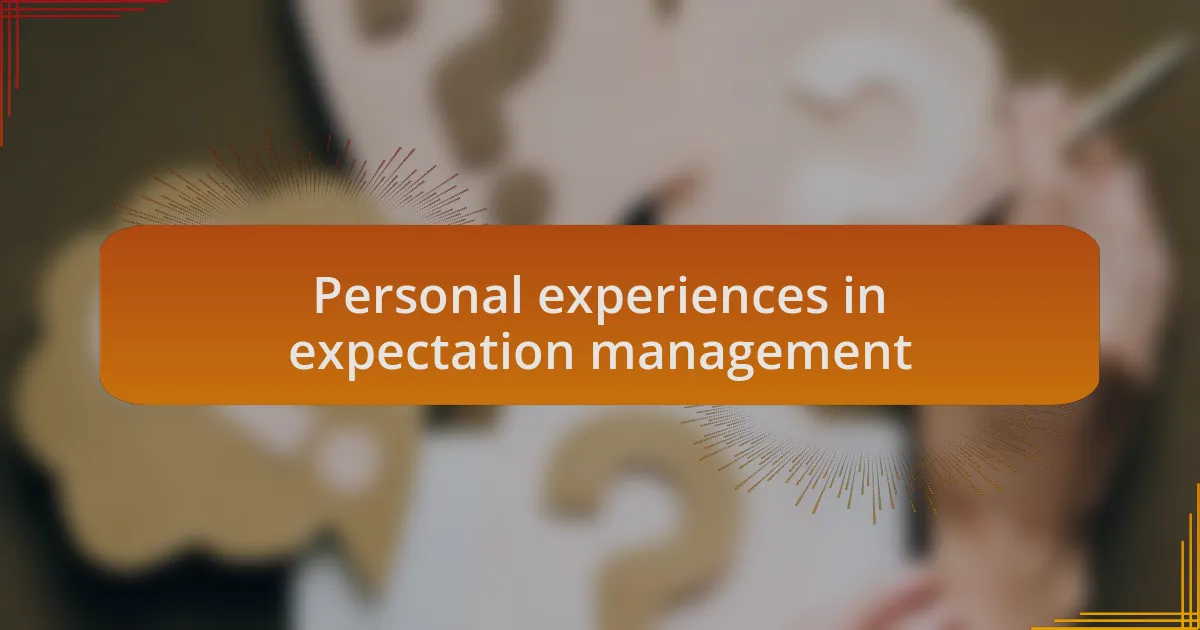
Personal experiences in expectation management
Managing donor expectations is a delicate balancing act. I remember a project where I enthusiastically promised a rapid timeline for changes we were introducing. However, midway through, it became clear that we hit unexpected snags. Facing the prospect of missing our deadlines, I chose to reach out to the donors proactively. I explained the roadblocks we encountered and shared my revised timeline. This honesty not only eased their concerns but also set realistic expectations, reinforcing our partnership. How often do we underestimate the power of a transparent conversation?
Another experience that stands out involved a major donor whose expectations were high due to previous successes. As we embarked on a new initiative, I made it clear that while I was excited, there remained uncertainties in execution. To bridge this gap, I organized regular updates that included both achievements and challenges. This approach allowed us to celebrate our wins together while also discussing the hurdles, creating a sense of shared ownership. Isn’t it fascinating how keeping donors in the loop can turn them into allies rather than just benefactors?
Lastly, there was a time when a donor expressed frustration over a misaligned expectation regarding outcomes. Instead of dismissing their feelings, I invited them to a coffee chat. During that conversation, I listened intently, which not only validated their concerns but deepened the respect we had for one another. Sometimes, by simply being there for our donors and showing empathy, we can transform a potentially damaging situation into a chance for growth. Would you agree that listening often speaks louder than mere words?
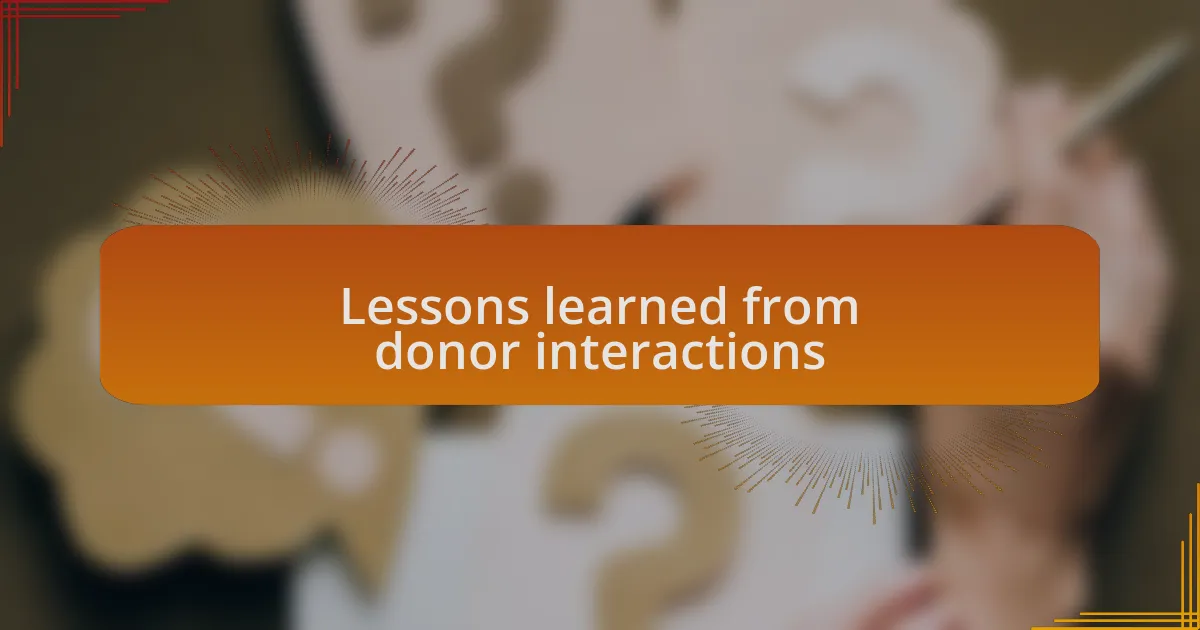
Lessons learned from donor interactions
In my journey of managing donor expectations, I’ve learned that assumptions can be dangerous. I once assumed a donor understood the complexities of our financial reporting. To my surprise, during a meeting, they expressed confusion about our budget allocations. This prompted me to take a step back and simplify the way we present our financial data. Have you ever realized that a little clarity can go a long way in building trust?
One pivotal lesson came from a donor who was unaccustomed to a slower-paced project. They were eager for results, unaware that significant societal change takes time. After several candid discussions, I learned to reshape our narrative and frame success in terms of incremental progress rather than just final outcomes. This shift not only adjusted their expectations but also fostered a deeper understanding of our mission. Isn’t it incredible how reframing our approach can convert impatience into patience?
Lastly, I found that proactive communication is key when facing setbacks. In a challenging project, I was upfront about a delay caused by external factors. By sharing the details and potential solutions early on, I transformed their initial disappointment into a collaborative conversation. It reinforced the notion that transparency, even during tough times, cultivates stronger relationships. Can you think of a time when open dialogue led to unexpected positive outcomes in your own experiences?
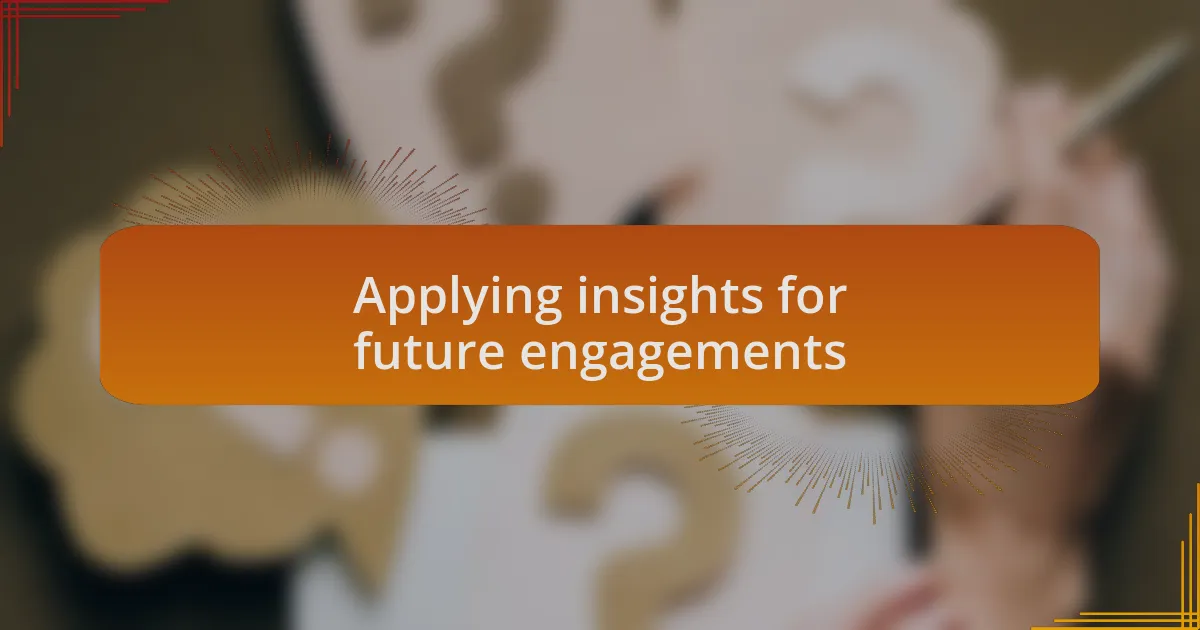
Applying insights for future engagements
When I reflect on how to apply insights from my donor interactions, I recognize the importance of tailoring communication based on individual donor preferences. One time, I designed a customized progress report for a supporter who preferred a visual approach. Using infographics and charts made the information more digestible and engaging for them, which ultimately led to increased contributions. Have you ever considered how adapting your communication style can enhance donor relationships?
Another vital insight I’ve applied is the value of creating shared goals with donors. I recall a conversation with a donor who felt disconnected from our mission. By involving them in the planning process of a new initiative, we co-created milestones together. This not only ignited their enthusiasm but also fostered a sense of ownership in our shared vision. Isn’t it powerful to think about how inclusion can turn apprehension into commitment?
Moreover, I’ve learned that feedback should be a two-way street. After each project, I make it a priority to seek opinions from my donors about their experiences and insights. This openness has led to invaluable suggestions that helped refine our strategies. Sometimes, the most profound revelations come from those who are walking alongside us. How often do you solicit feedback to enhance your engagements?